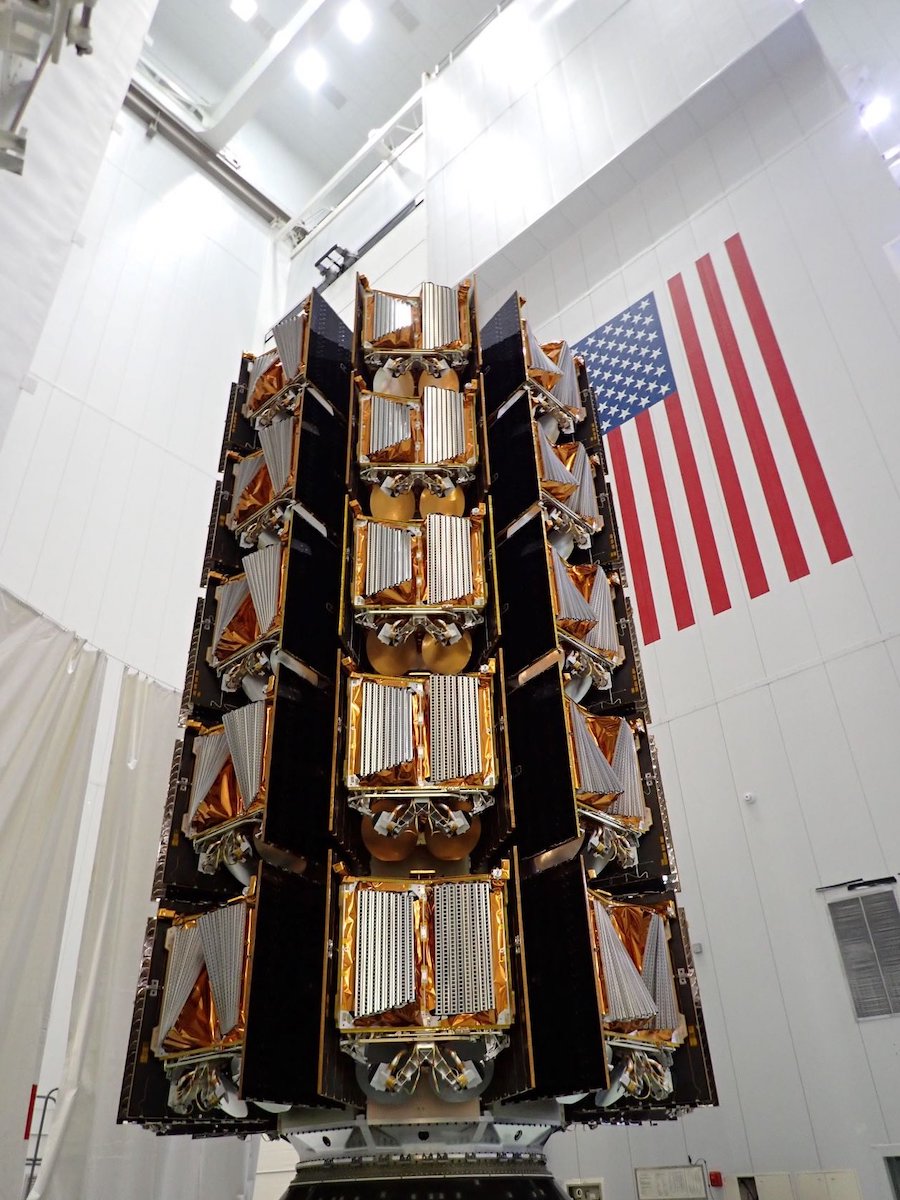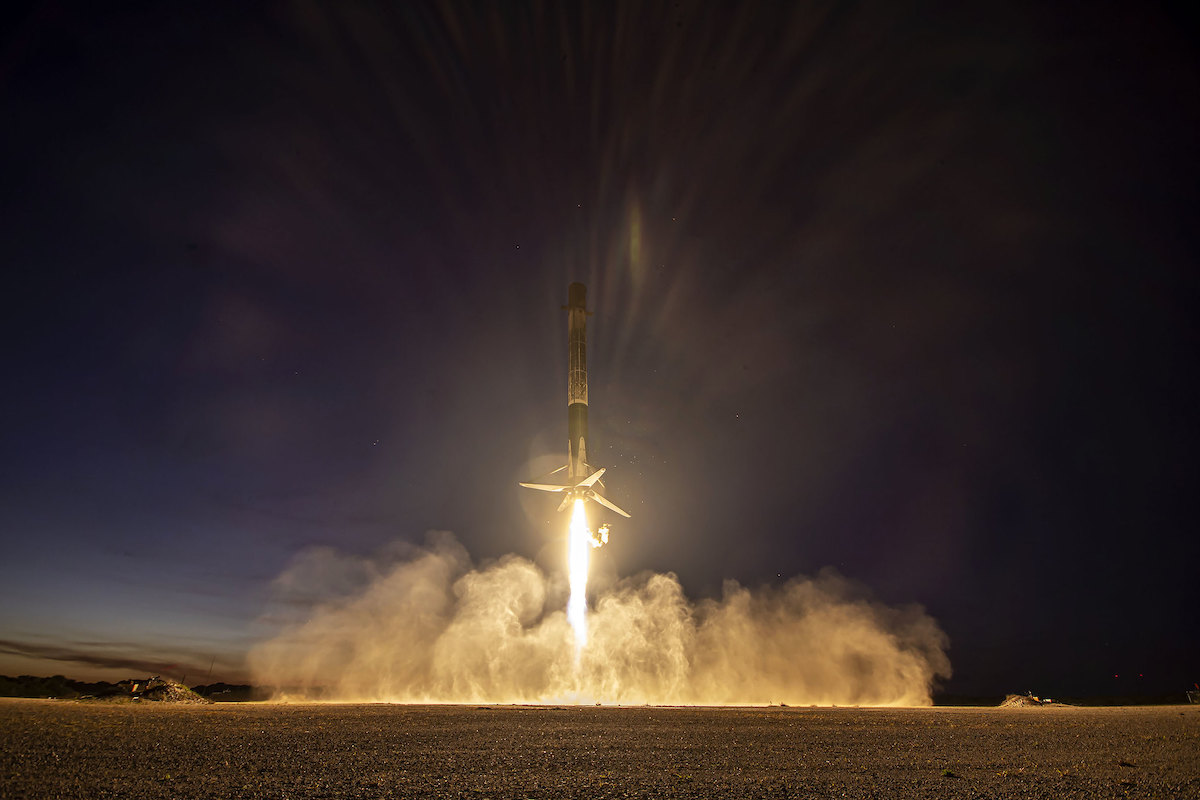
OneWeb’s broadband network will get a boost from SpaceX, which operates its own internet constellation, with the launch of 40 satellites on top of a Falcon 9 rocket set for Thursday from Kennedy Space Center.
The 40 satellites are packaged inside the nose cone of the Falcon 9 rocket undergoing final preparations for rollout to pad 39A at Kennedy. Once the rocket arrives at the pad, it will be raised vertical for final countdown preparations ahead of liftoff set for 5:27 p.m. EST (2227 GMT).
There is a 90% chance of favorable weather for launch Thursday, according to the U.S. Space Force’s 45th Weather Squadron. Forecasters predict mostly clear skies for the sunset launch attempt, with mild temperatures and north winds.
The launch was delayed from earlier in the week as SpaceX prepared the Falcon 9 launcher inside a hangar a quarter-mile south of pad 39A.
SpaceX’s launch team will turn over control of the Falcon 9 countdown to an automated computer sequencer 35 minutes before liftoff. About a million pounds of super-chilled, densified kerosene and liquid oxygen will be pumped into the 229-foot-tall (70-meter) rocket ahead of the 5:27 p.m. launch time.
The Falcon 9’s on-board computer will take control of the countdown a minute before launch, overseeing final pressurization of propellant tanks and the engine startup sequence. The rocket’s nine Merlin engines will flash to life and throttle up to full power, and assuming they pass a final health check, hold-down clamps will open to release the Falcon 9 to begin its climb off the launch pad.
The rocket will head south-southeast from Kennedy Space Center on a trajectory over the Atlantic Ocean, then turn south to fly parallel to Florida’s East Coast. The southerly launch trajectory will allow the Falcon 9 to place the 40 OneWeb satellites into a polar orbit.
SpaceX launched its first polar orbit mission from Cape Canaveral Space Force Station in 2020, using the southern launch corridor for the first time since 1969. The OneWeb mission Thursday will be SpaceX’s eighth polar orbit launch from Florida, and the first to take off from pad 39A, the historic seaside facility originally used for Saturn 5 rocket launches in the Apollo moon program.
The 40 OneWeb satellites are stacked on a vertical mount inside the Falcon 9’s payload fairing for the ride into orbit. The Falcon 9’s first stage booster will fire its nine engines for 2 minutes and 17 seconds, then shut down and fall away from the rocket’s upper stage. While the upper stage lights its single engine to accelerate to orbital velocity, the first stage will reignite three of its engines for a “boost back” burn to zero out its downrange velocity and head for landing at Cape Canaveral.
The booster, making its fourth flight to space, will perform two more retrorocket firings with a subset of its engines to slow for landing. Touchdown at Landing Zone 1 is expected 7 minutes and 45 seconds after launch. The rocket landing will be accompanied by double sonic booms that could be heard across Florida’s Space Coast.
The upper stage will complete its first burn eight-and-a-half minutes into the flight to place the OneWeb satellites into a preliminary parking orbit. A three-second restart of the upper stage’s Merlin Vacuum engine is scheduled 55 minutes after launch to circularize the orbit before deployment of the 40 OneWeb satellites.
The satellites will separate in groups over a half-hour, with the final set of spacecraft expected to separate from the rocket about 1 hour and 29 minutes into the missions.
The OneWeb satellites, each weighing about 325 pounds (147.5 kilograms at launch), will deploy solar panels and activate xenon ion thrusters to maneuver into their operational orbit at an altitude of 745 miles (1,200 kilometers).
OneWeb’s satellites are built in a factory just outside the gates of NASA’s Kennedy Space Center in Florida by a joint venture between OneWeb and Airbus Defense and Space. The satellites are are designed to beam low-latency broadband internet signals to customers around the world. Based in London, OneWeb is one of several operators either already launching large fleets of internet satellites, or planning to begin launches soon.
SpaceX has launched more than 3,500 Starlink internet satellites using the company’s own Falcon 9 rockets.
OneWeb has launched 464 satellites of a planned first-generation constellation of 648 spacecraft using 13 Russian Soyuz rockets purchased through Arianespace, the French launch services provider, and one flight on an Indian GLSV Mk.3 rocket. Amazon plans to launch its first two prototype internet satellites of a planned constellation of 3,236 spacecraft next year on the first flight of United Launch Alliance’s new Vulcan rocket.

OneWeb’s launch plans were interrupted earlier this year after Russia’s invasion of Ukraine.
Arianespace was on the hook with OneWeb for six more Soyuz launches from the Baikonur Cosmodrome in Kazakhstan, including a 14th launch that was set to take off in March. But Russia’s space agency set conditions on the mission after rolling the rocket and the OneWeb satellites to a launch pad at Baikonur, including a demand that the UK government give up its stake in OneWeb.
The UK government declined, and OneWeb announced March 3 it was suspending launches from Baikonur. OneWeb reported a loss of $229.2 million on its financial statements as a result of the termination of the planned Soyuz launch in March. The financial charge also covers losses associated with the postponement of subsequent Soyuz missions, and the loss of 36 satellites stranded in Kazakhstan and not returned to OneWeb by Russia, which runs the Baikonur Cosmodrome.
Less than a month after Soyuz launches were suspended, OneWeb announced an agreement with SpaceX to launch some of its remaining satellites. OneWeb finalized a similar agreement with New Space India Limited, or NSIL, the commercial arm of India’s space agency, for launches on Indian rockets.
The contract with SpaceX was surprising to many satellite industry watchers because OneWeb is an indirect competitor in broadband market. SpaceX sells Starlink service directly to consumers, while OneWeb sells to enterprises and internet service providers to provide connectivity for entire businesses or communities.
Including Thursday’s mission, OneWeb has five launches remaining to finish deploying its first-generation broadband constellation. Four of them are booked on SpaceX Falcon 9 rockets, and OneWeb has one more launch reserved with NSIL for another GSLV Mk.3 launch next year.
Email the author.
Follow Stephen Clark on Twitter: @StephenClark1.
